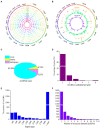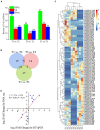Identification and Functional Prediction of Poplar Root circRNAs Involved in Treatment With Different Forms of Nitrogen
- PMID: 35874008
- PMCID: PMC9305699
- DOI: 10.3389/fpls.2022.941380
Identification and Functional Prediction of Poplar Root circRNAs Involved in Treatment With Different Forms of Nitrogen
Abstract
Circular RNAs (circRNAs) are a class of noncoding RNA molecules with ring structures formed by covalent bonds and are commonly present in organisms, playing an important regulatory role in plant growth and development. However, the mechanism of circRNAs in poplar root responses to different forms of nitrogen (N) is still unclear. In this study, high-throughput sequencing was used to identify and predict the function of circRNAs in the roots of poplar exposed to three N forms [1 mM NO3 - (T1), 0.5 mM NH4NO3 (T2, control) and 1 mM NH4 + (T3)]. A total of 2,193 circRNAs were identified, and 37, 24 and 45 differentially expressed circRNAs (DECs) were screened in the T1-T2, T3-T2 and T1-T3 comparisons, respectively. In addition, 30 DECs could act as miRNA sponges, and several of them could bind miRNA family members that play key roles in response to different N forms, indicating their important functions in response to N and plant growth and development. Furthermore, we generated a competing endogenous RNA (ceRNA) regulatory network in poplar roots treated with three N forms. DECs could participate in responses to N in poplar roots through the ceRNA regulatory network, which mainly included N metabolism, amino acid metabolism and synthesis, response to NO3 - or NH4 + and remobilization of N. Together, these results provide new insights into the potential role of circRNAs in poplar root responses to different N forms.
Keywords: Populus × canescens; ceRNA regulatory network; circular RNAs; different nitrogen forms; roots.
Copyright © 2022 Zhou, Yang, Jia, Shi, Deng and Luo.
Conflict of interest statement
The authors declare that the research was conducted in the absence of any commercial or financial relationships that could be construed as a potential conflict of interest.
Figures






Similar articles
-
Identification and Functional Prediction of CircRNAs in Leaves of F1 Hybrid Poplars with Different Growth Potential and Their Parents.Int J Mol Sci. 2023 Jan 23;24(3):2284. doi: 10.3390/ijms24032284. Int J Mol Sci. 2023. PMID: 36768607 Free PMC article.
-
Genome-Wide Identification and Characterization of Long Noncoding RNAs in Populus × canescens Roots Treated With Different Nitrogen Fertilizers.Front Plant Sci. 2022 May 12;13:890453. doi: 10.3389/fpls.2022.890453. eCollection 2022. Front Plant Sci. 2022. PMID: 35646010 Free PMC article.
-
Nitrate/ammonium-responsive microRNA-mRNA regulatory networks affect root system architecture in Populus × canescens.BMC Plant Biol. 2022 Mar 4;22(1):96. doi: 10.1186/s12870-022-03482-3. BMC Plant Biol. 2022. PMID: 35246022 Free PMC article.
-
Circular RNAs roll into the regulatory network of plants.Biochem Biophys Res Commun. 2017 Jun 24;488(2):382-386. doi: 10.1016/j.bbrc.2017.05.061. Epub 2017 May 10. Biochem Biophys Res Commun. 2017. PMID: 28501625 Review.
-
Circular RNAs and Plant Stress Responses.Adv Exp Med Biol. 2018;1087:345-353. doi: 10.1007/978-981-13-1426-1_27. Adv Exp Med Biol. 2018. PMID: 30259379 Review.
Cited by
-
Epigenetics in Plant Response to Climate Change.Biology (Basel). 2025 May 29;14(6):631. doi: 10.3390/biology14060631. Biology (Basel). 2025. PMID: 40563882 Free PMC article. Review.
-
Advances in CircRNAs in the Past Decade: Review of CircRNAs Biogenesis, Regulatory Mechanisms, and Functions in Plants.Genes (Basel). 2024 Jul 21;15(7):958. doi: 10.3390/genes15070958. Genes (Basel). 2024. PMID: 39062737 Free PMC article. Review.
-
Identification and characterization of CircRNA-associated CeRNA networks in moso bamboo under nitrogen stress.BMC Plant Biol. 2023 Mar 14;23(1):142. doi: 10.1186/s12870-023-04155-5. BMC Plant Biol. 2023. PMID: 36918810 Free PMC article.
-
Identification and Functional Prediction of CircRNAs in Leaves of F1 Hybrid Poplars with Different Growth Potential and Their Parents.Int J Mol Sci. 2023 Jan 23;24(3):2284. doi: 10.3390/ijms24032284. Int J Mol Sci. 2023. PMID: 36768607 Free PMC article.
-
miRNA-seq analysis revealed a potential strategy underlying poplar root responses to low nitrogen stress.Planta. 2025 Mar 11;261(4):87. doi: 10.1007/s00425-025-04663-8. Planta. 2025. PMID: 40067492
References
-
- Bi Y. M., Zhang Y., Signorelli T., Zhao R., Zhu T., Rothstein S. (2005). Genetic analysis of Arabidopsis GATA transcription factor gene family reveals a nitrate-inducible member important for chlorophyll synthesis and glucose sensitivity. Plant J. 44, 680–692. doi: 10.1111/j.1365-313X.2005.02568.x, PMID: - DOI - PubMed
LinkOut - more resources
Full Text Sources

